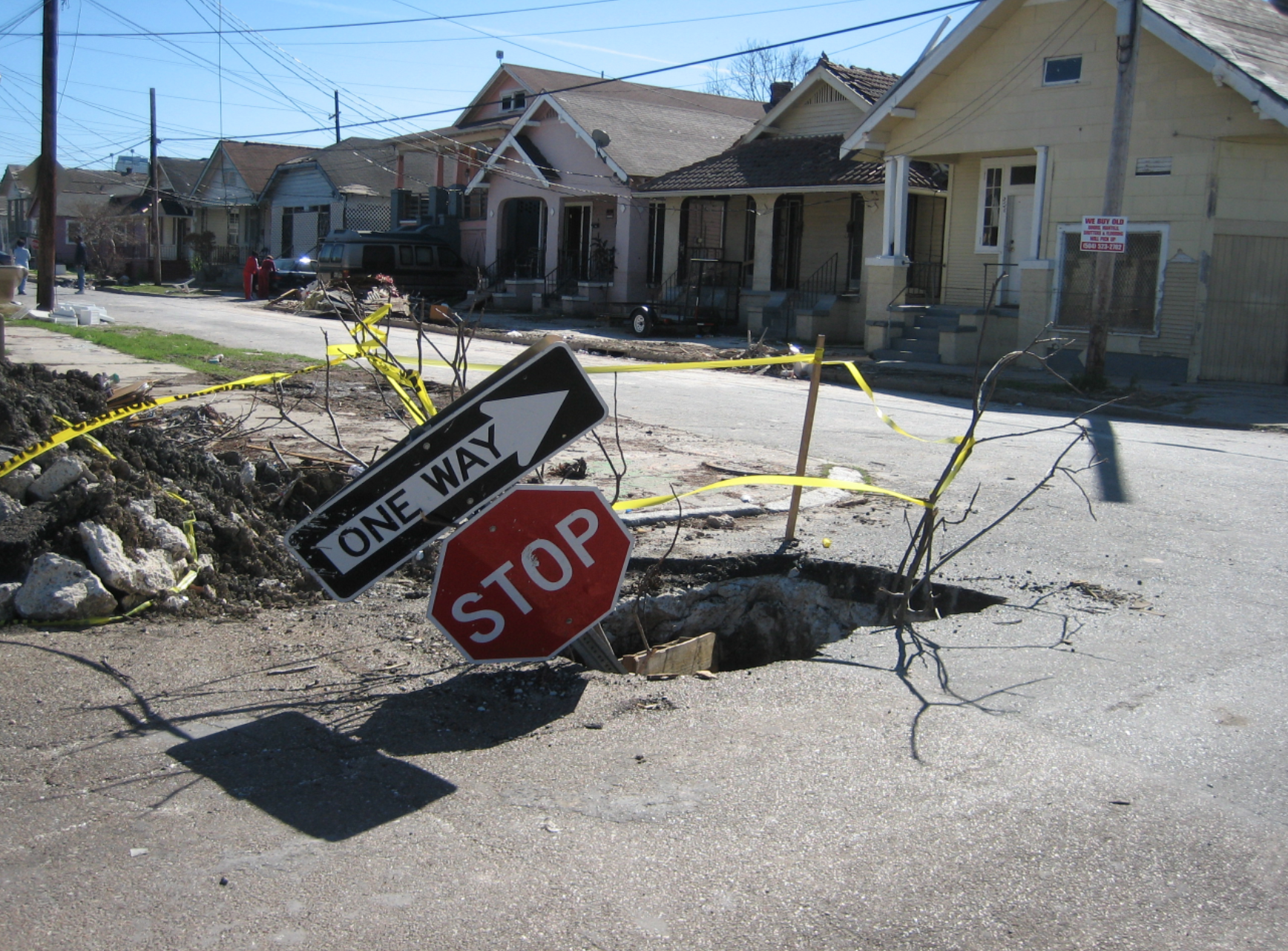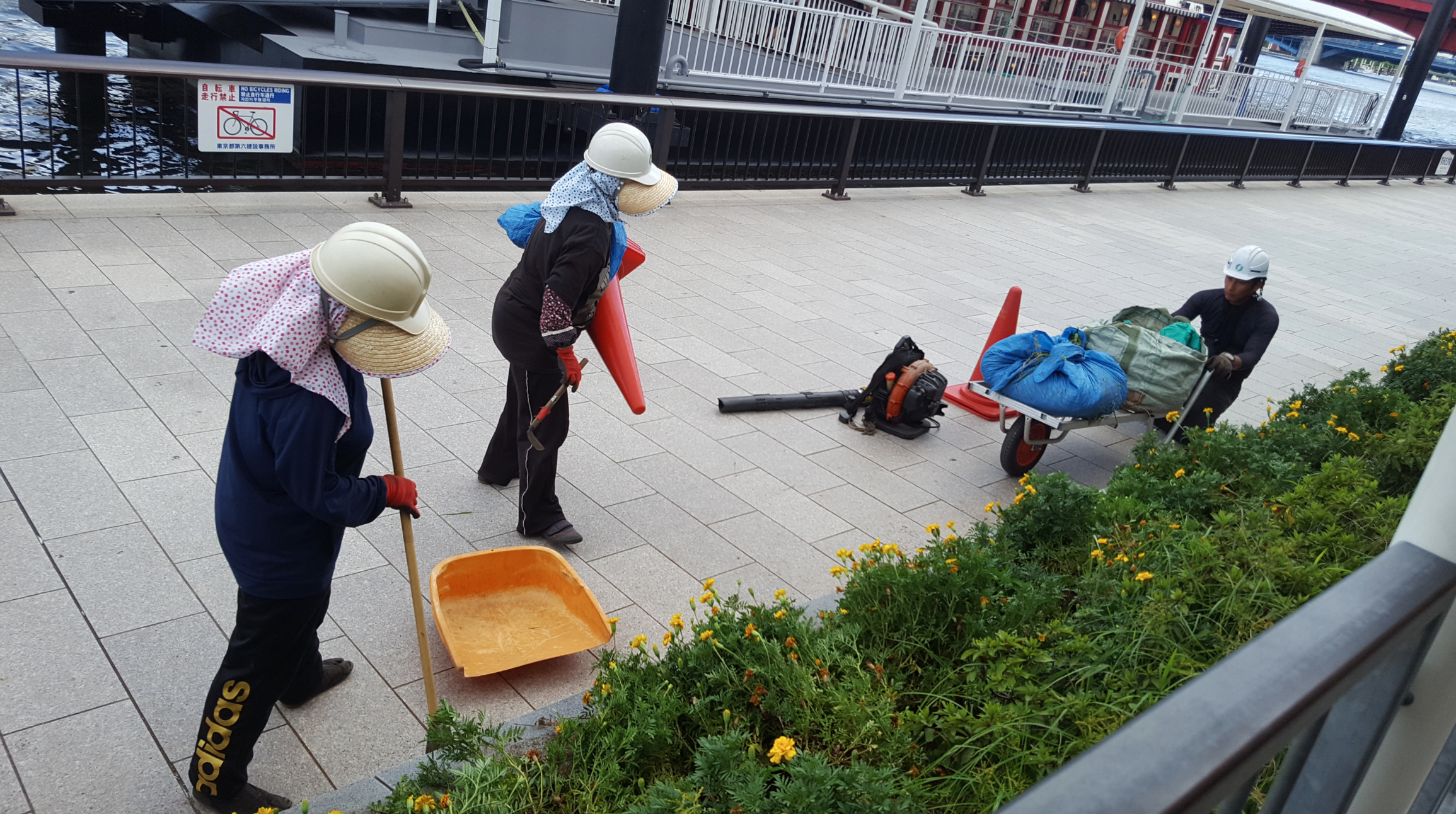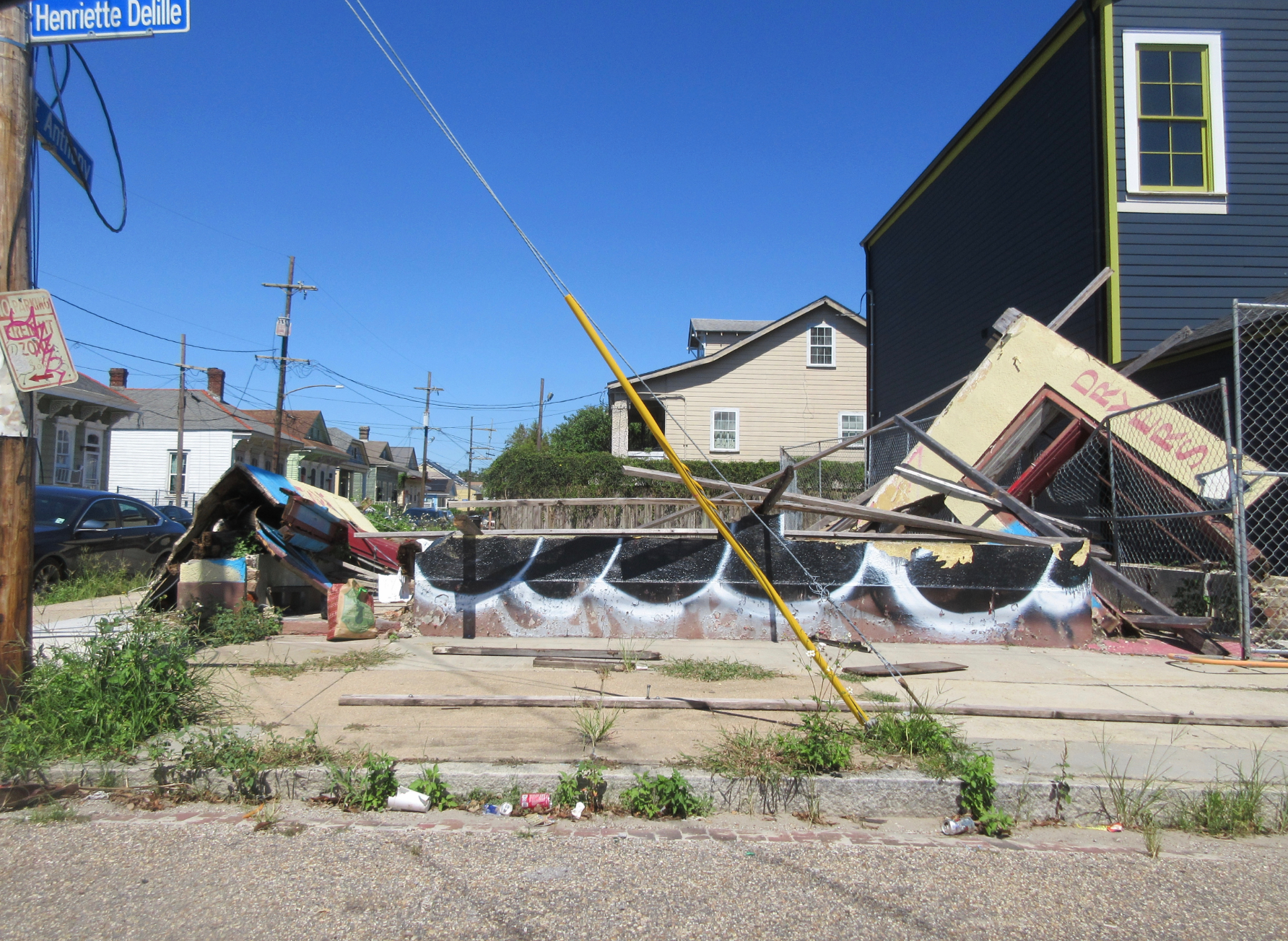Section I: The Issue
Stepping out of the Louis Armstrong Airport on a humid summer day, you get into the car, excited to head back to Tulane’s campus. Zooming down I-10, you clench the seatbelt of your Uber, holding on as he goes 95 miles per hour down the road. All of a sudden, boom. A highway sign slashes a black Sudan down the center of the vehicle, showing no mercy. The car folds, and cops come, saving the patrons from danger. You continue with your drive back to Tulane, but the car stops, and as you peer through the windshield, you see hundreds of Ford F-150s, bumper to bumper, down the interstate. As you approach Uptown New Orleans, the car starts to bounce, and you go flying in the vehicle. Curious as to why the car is jumping, you look out the window and see the street lined up and down with potholes bigger than the car.
Aside from potholes, New Orleans is considered the ninth most congested city in the United States. Although it might just seem like the city is filled with terrible drivers, there are actual concrete reasons as to why the traffic and backup are so bad. The traffic lights never seem to be timed correctly, or they are just out entirely. This leads to traffic all over the city, causing immense backups. At the corner of Decatur and Toulouse, the traffic light was out for over four months, causing cars to sit and wait for hours. After Hurricane Ida, over 463 traffic lights were out all over the city, and although almost half were fixed within a month, it still left half of the lights out for several months. The city claimed it would cost about five billion dollars to fix streets after a natural disaster such as a hurricane, but the city only budgets $1.5 billion, which is not enough to cover the costs. Also, New Orleans drivers lose more than 79 hours a year to sitting in traffic and pay about $977.02 in gas prices for that wait. When commuting to work, New Orleans residents are quick to be selfish, driving alone and taking up space on the road. Although it is convenient for 68.5% of residents to drive alone, that correlates to thousands of cars each and every day.
It is difficult to travel through New Orleans and not experience some sort of road damage every six blocks. The potholes rank the city’s street conditions at 43/100. New Orleans resident Laura Maneaux has experience with poor road conditions, constantly battling the potholes and the effects they have on her car. “It’s causing problems,” Maneaux says. “It ripples back to your car with tires and those things under the hood that are very expensive to get repaired.” Aside from the annoyance and uncomfortable factor of the potholes lining the streets, they are causing financial barriers to residents. The torn roads rip the shocks off of residents’ cars, causing them to spend thousands of dollars to replace their vehicles more than one time a year. “In the past two and a half years, I’ve had to replace the shocks on my car twice,” Maneaux says. It can cost New Orleans residents upwards of $685 a year in extra vehicle costs to compensate for the damage from the broken roads. After a two million dollar estimate on how to solve the pothole issue affecting every New Orleans resident, the city still has not fully addressed the issue at hand, showing what the priorities of the city are.

Large pothole with a road sign in the middle (Photo by Infrogmation- Wikimedia Commons).
All across New Orleans, more specifically Uptown and around Tulane’s campus, garbage rots on the side of the roads. There are overflowing trash bags that line the streets of the city, spilling over with plastic bottles, glass bottles, and just general trash. The lack of attention to garbage pickup is largely due to a shortage of workers, mainly because of Covid-related issues. The overflow of trash is not only unpleasant to look at, but residents of New Orleans are at an increased risk of health issues. The strength of the Louisiana heat intensifies the foul smell, causing it to linger down almost every road and neighborhood. Although the lack of attention to the trash in New Orleans is an ongoing issue in the city, it becomes even more intensified after storms hit the city. Following Hurricane Ida, residents of New Orleans could see swarms of flies zooming throughout the neighborhoods, which can cause eye irritation, coughing, and loss of smell. After major natural disasters, the city lacks resources to pick up trash and keep the city in good condition, so the trash piles up while the citizens barricade themselves to keep the smell of trash away.
Looking at the damage in New Orleans, there are human rights issues at risk. People might become ill, lose their belongings, and have to pay large sums of money because of the conditions in New Orleans (Voigt and Thorton).
Section II: The Solution
Unlike the culture in New Orleans to party and leave the city a slight mess, there is an element of cleanliness instilled in Japanese culture. Through Covid scares and the risk of disease and illness, the element of cleanliness is very prevalent today, but this roots back in ancient times. Shinto (Norbeck, 269), an ancient Japanese religion similar to Buddhism, reinforced the idea that cleanliness is godliness. Today, similar practices are enforced in the country. At the end of the school day, once children are released from their desks, they do their school chores. They use brooms, vacuums, and cloths to dust around the classroom to make sure it is in great condition for the following school day.
Research has proven children are happier in cleaner environments, which is why Japan so heavily enforces these cleaning practices for school children. Children are very much encouraged to participate in the cleanup. In the early evening, kids go outside to the empty streets where they run around, collecting the small pieces of trash they find on the ground and then placing them in a trash bin. Although there’s not much trash to pick up because the country is already so clean, it enforces the idea of keeping Japan clean. These practices are ingrained in their culture, which makes cleaning and taking care of the country not as much of a chore. There are laws, such as the Waste Disposal and Cleaning Law Amendment (passed in 2010), which enhance waste disposal and recycling. Small practices like cleaning up in school, picking up trash off the ground, always being aware of how clean/dirty your surroundings are, and larger practices such as laws help keep Japan as clean as it is today. Japan is currently ranked one of the cleanest countries globally.

Residents of Japan engaging in cleaning techniques (Photo by Flarthurhu- Wikimedia Commons).
Similar to New Orleans, Japan experiences natural disasters, such as tsunamis and earthquakes, that can cause detrimental damage to the nation. After a natural disaster in Japan, citizens mourned but got the right to work to help rebuild the nation. Following the destructive earthquake and tsunami in 2011 (Norio), the country faced damage of 550 billion yen. Fallen buildings and debris flooded the ground, making it challenging for Japanese citizens to move around the country. 123,000 houses were destroyed, and there was severe damage to almost a million more. Almost every street was blocked off, either flooded or completely damaged by the fallen buildings. Rather than waiting for the government to clear a special natural disaster clean-up budget, residents put their effort together to begin the cleanup. It is not simple to clean the land after a major natural disaster, but the teamwork and effort to keep Japan beautiful was a motivating factor for many. Aside from cleanup, residents roamed the streets with plastic containers of water, offering support and supplies to those laboring. Workers and citizens from all different areas of expertise, whether that be manual labor or the average citizen just pitching in and lending a hand, Japan was able to clean up and have the nation recover from the disaster faster than waiting for the government to do it. Right after the disaster, Japan set a timeline of 10 years to recover, and as of 2019, they have been following the timeline, ensuring the debris was either incinerated or recycled and infrastructure has been reconstructed.
Another tactic Japan uses to keep the country clean is an aspect of competition cleaning and speed cleaning. Citizens of Japan are so dedicated to keeping the country clean that after any major sporting event, concert, etc., people will stay in the stadium to clean. Not only is this done for events in Japan, but if there is an away game or residents of Japan are at an event in a different country, they will do the same and hold themselves to the same cleaning standard. Because of this dedication, cleaning in Japan has now turned into an actual sports competition. The Spo-Gami contests, which originated in 2008, allow residents to compete for cleanliness. Teams of three to five individuals will roam around designated areas of the nation and pick up trash with tongs within a certain timeframe. On October 13, 2018, 63 individuals across 14 different teams collected 135.25 kg of trash. Competition drives success, and in this case, success comes from a clean country. Besides competition, speed cleaning is used to keep Japan clean. Individuals line the main train in Japan dressed in pink uniforms. When the clock starts for seven minutes, the Shinkansen cleaning crew checks the luggage rack, wipes down surfaces, sweeps, and takes the trash out. The rushed cleaning allows for optimal cleanliness, and a deadline gives an incentive to keep the train as clean as possible. In 2007, The Angel Report claimed this method raised morale among employees and allowed the train to live up to the expectations of its riders.
Tokyo, Japan, has an average air quality of 45, which is in the “good” category. Compared to other cities in Japan and around the world, this is very high. Tourists say that the streets in Japan are spotless, and this can be credited to the absence of trash cans. Although this sounds counterintuitive, in Japan they have other ways to dispose of trash and eliminate litter, such as handing garbage back to where you got it and implementing mass recycling programs.
Section III: New Orleans
New Orleans can implement Japanese practices by gathering the community to work together to clean up the city. In order to start this project, there needs to be a larger emphasis on keeping the city clean. A structural change would have to occur within the city to get individuals in the correct mindset of wanting a clean city. If individuals have the mindset of wanting a clean city, they will work towards it.
First, New Orleans can create an incentive program for people to help clean the city and fill potholes. Japan’s competition technique could prove effective in this sense. Different streets or blocks, depending on where in the city you live, can form a “team” that must work together to clean up their section. There would be a certain timeframe, such as a day dedicated to service, where residents would team up and clean. A prize can be determined based on what neighborhood you live in, and the cleanest street in that neighborhood would win the prize. Prizes can come from local sponsors that care about keeping New Orleans clean. Donors should be New Orleans-based companies that have strong ties and a passion for New Orleans. This competition can be a bi-yearly event, one in the spring and one in the fall, so residents have something to look forward to but don’t feel like they are pressured to spend all day cleaning too often.
Also, there should be more of an emphasis on cleaning/fixing New Orleans after natural events such as hurricanes. It is important to make sure the city is rebuilding neighborhoods and cleaning in a way that supports community health and well-being (Catalani). Hurricane debris can last for years if it is not picked up in a timely manner. It is obviously devastating to witness a hurricane and emotionally have to process the damage, but the sooner it is cleaned up, the closer New Orleans will get to normalcy. The city can implement Japanese techniques of people cleaning up right after a disaster happens to ensure the city will be in the best condition possible. Teams of individuals can sign up based on their strengths to target a certain part of the city or a certain task they feel they will have the greatest impact on. By doing this, individuals feel like they are directly making an impact and using their strengths to the advantage of the city.

Destruction in New Orleans from Hurricane Ida in September 2021 (Photo by Infrogmation of New Orleans- Wikimedia Commons).
After Mardi Gras and other festivals in the city, New Orleans has cleaning crews to get the city back to normal, but residents of New Orleans can have a greater role in this. In Japan, after certain holidays, residents will gather and work together to clean the city, and the same should happen in New Orleans. Again, people can register to target a specific area based on their strengths or passions so they feel motivated to work. The city will be cleaned faster this way, and residents will become more involved in the city and more motivated to keep it looking and feeling clean since they put in so much work to do so.
Although people might not feel motivated to clean or want to clean, they should know it is best for the city to participate. It also might be logistically difficult to gather that many people to work in the city, but it is in the city’s best interest to do so.
Works Cited
Catalani, Caricia E. C. V., et al. “Videovoice: Community Assessment in Post-Katrina New Orleans.” Health Promotion Practice, vol. 13, no. 1, Jan. 2012, pp. 18–28, https://journals.sagepub.com/doi/full/10.1177/1524839910369070.
Norbeck, E. (1952). Pollution and Taboo in Contemporary Japan. Southwestern Journal of Anthropology, 8(3), 269–285. https://doi.org/10.1086/soutjanth.8.3.3628658
Norio, Okada, et al. “The 2011 Eastern Japan Great Earthquake Disaster: Overview and Comments.” International Journal of Disaster Risk Science, vol. 2, no. 1, 2011, pp. 34–42. Crossref, https://link.springer.com/article/10.1007/s13753-011-0004-9.
Voigt, Lydia, and William E. Thornton. “Disaster-Related Human Rights Violations and Corruption: A 10-Year Review of Post–Hurricane Katrina New Orleans.” American Behavioral Scientist, vol. 59, no. 10, Sept. 2015, pp. 1292–1313, https://journals.sagepub.com/doi/10.1177/0002764215591185.
 NOLAbeings Multimedia artist Claire Bangser created NOLAbeings as a portrait-based story project that marries...
NOLAbeings Multimedia artist Claire Bangser created NOLAbeings as a portrait-based story project that marries...  Voodoo in New Orleans: Reviving history: New Orleans fortune telling This article takes a deep dive into the history of Voodoo in New Orleans, its hybridization with Catholicism, and its present-day place in the city's culture. The author visits fortune-tellers in the French Quarter, using their guidance as a tool for introspection rather than a deterministic predictor of the future. Through her experiences in New Orleans, the author feels a mystical connection to both the past and the future.
Voodoo in New Orleans: Reviving history: New Orleans fortune telling This article takes a deep dive into the history of Voodoo in New Orleans, its hybridization with Catholicism, and its present-day place in the city's culture. The author visits fortune-tellers in the French Quarter, using their guidance as a tool for introspection rather than a deterministic predictor of the future. Through her experiences in New Orleans, the author feels a mystical connection to both the past and the future. 